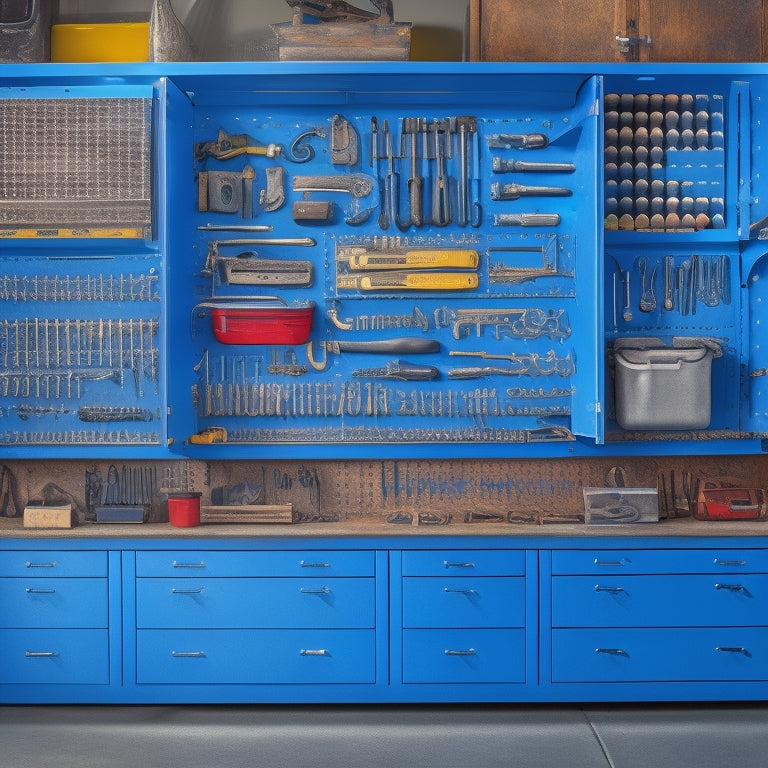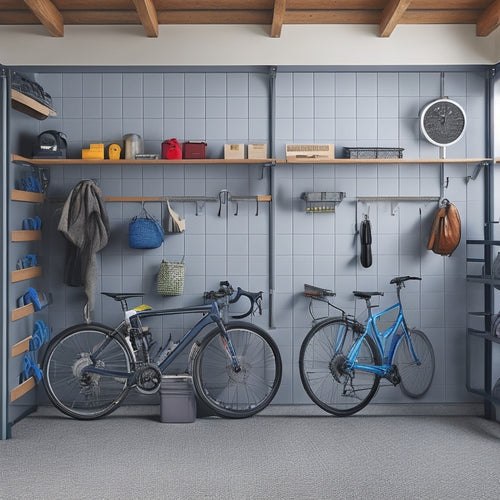
3 Essential Tips for Efficient Tool Storage Systems
Share
You can turbocharge your productivity by implementing an efficient tool storage system that streamlines your workflow and keeps your workspace organized. First, optimize tool accessibility by strategically placing your most frequently used tools and designating specific zones for different tool types. Next, maximize storage capacity by evaluating available space, using vertical organization, and implementing drawer dividers. Finally, customize your system to accommodate specific tools and tasks, investing in customizable storage bins and space-saving solutions like wall-mounted pegboards. By applying these essential tips, you'll be well on your way to a more efficient workspace - and there's even more to explore.
Key Takeaways
• Strategically place frequently used tools for easy access to reduce search time and improve productivity.
• Utilize vertical organization and overhead storage to maximize storage capacity and reduce clutter.
• Designate specific zones for different tool types and implement drawer dividers for categorized tool storage.
• Invest in customizable storage bins that cater to unique tool dimensions for secure storage and easy accessibility.
• Explore space-saving solutions like wall-mounted pegboards, foldable workstations, and multi-tiered shelving units to optimize available space.
Optimizing Tool Accessibility
By strategically placing your most frequently used tools in convenient areas, you can greatly reduce the time spent searching for them, allowing you to stay focused on the task at hand.
Effective tool organization is key to achieving space efficiency in your workshop or garage. When you can easily see and access the tools you need, you'll work more efficiently and avoid wasting time searching for misplaced items.
Consider designating specific zones for different types of tools, such as a section for hand tools, another for power tools, and a third for measuring and testing equipment. This will enable you to quickly locate the tools you need, even when working on complex projects.
Additionally, ensuring easy access and tool visibility will help you maintain a clutter-free workspace, reducing the risk of accidents and improving overall productivity.
Maximizing Storage Capacity
To maximize storage capacity in your workshop or garage, you'll want to assess your available space and identify opportunities to optimize your storage system, taking into account the size, shape, and frequency of use of each tool. By doing so, you can create a more efficient and organized storage system that makes the most of your space.
Here are some tips to help you maximize your storage capacity:
-
Use vertical organization: Install shelves, hooks, or a pegboard to take advantage of your ceiling height and keep frequently used tools within easy reach.
-
Implement drawer dividers: Separate your tools into categories and store them in labeled drawers with dividers to prevent clutter and make it easier to find what you need.
-
Take advantage of overhead storage: Install overhead shelves or bins to store infrequently used tools or accessories, keeping them out of the way but still accessible.
- Utilize pegboard solutions: Hang a pegboard on a wall or the back of a door and use hooks, bins, and other accessories to store tools and supplies, keeping them organized and within reach.
Customizing for Unique Needs
You'll find that a one-size-fits-all approach to tool storage often falls short, and that's where customizing for your specific needs comes in - tailoring your system to accommodate particular tools, tasks, and work styles that require special attention. By doing so, you'll create a personalized organization that caters to your individual requirements, making it simpler to find what you need when you need it.
For instance, if you have oversized or irregularly shaped tools, consider investing in customizable storage bins or baskets that can be tailored to fit their distinct dimensions. This will ensure they're securely stored and easily accessible, while also maximizing your available space.
Additionally, look for space-saving solutions such as wall-mounted pegboards, foldable workstations, or multi-tiered shelving units that can help optimize your workshop or garage's layout.
Frequently Asked Questions
How Often Should I Clean and Maintain My Tool Storage System?
"You're probably thinking, 'I'll clean my tool storage system when it's a mess,' but don't wait! Clean and maintain it regularly to prevent clutter. Aim for a weekly tidy, and a deeper clean every 3-6 months to keep your tools organized and within reach."
Can I Use a Tool Storage System in a Small Workshop or Garage?
You can definitely use a tool storage system in a small workshop or garage by opting for space-saving solutions like wall-mounted racks and shelves, and exploring customization options to maximize your limited space.
Are Tool Storage Systems Suitable for Heavy Machinery and Equipment?
You'll need heavy-duty organization and large-scale storage solutions for your heavy machinery and equipment, ensuring safe and efficient access while maximizing your workshop or garage space.
Can I Install a Tool Storage System Myself or Do I Need a Professional?
Think of installing a tool storage system like assembling IKEA furniture - it's doable, but tricky. If you're handy, DIY installation can save you money, but if you're short on time or unsure, consider hiring a pro for convenience and peace of mind.
Are Tool Storage Systems Compatible With Different Tool Brands and Types?
You'll find that most tool storage systems cater to various tool brands and types, offering compatibility and adaptability. Look for systems with adjustable compartments and dividers to organize tools by type, ensuring a tailored fit for your specific tool collection.
Related Posts
-

Choosing the Right Stacked Storage Bins
When choosing the right stacked storage bins, you'll want to evaluate your storage needs, considering inventory types...
-

Key Features of a Garage Wall Hanging System
You're looking for a garage wall hanging system that's built to last and adapts to your needs. Look for systems made ...
-

What Are the Advantages of a Wooden Tool Box
You choose a wooden tool box, you're not only getting a reliable storage solution, but also a long list of benefits t...


